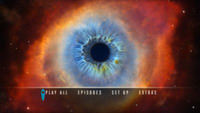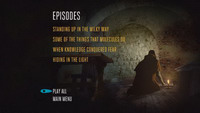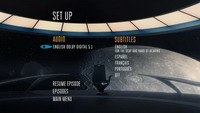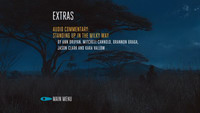
28.7.2014 #583
by Guido Bibra
• Library of Congress Dedication
• Cosmos at ComicCon
• Cosmos: The Voyage Continues Documentary
![]() The Documentary
The Documentary
In the 1960s and 1970s, the idea of making expensive multi-episode television documentaries was only slowly emerging. Single one-off documentaries were common even in the USA, but it was the English BBC who became the frontrunner and revolutionised the television industry. It started in the late 1960s with the first blockbuster productions Civilisation and The Ascent of Man, which were later followed by Life on Earth from David Attenborough, who had set the whole documentary wave into motion when he was the BBC controller. Meanwhile in the USA, the astronomer Carl Sagan had set out to bring science and astronomy to the masses with a similarly huge project simply called Cosmos. The impact of the thirteen episode long series was enormous and influenced a whole generation of students and scientists in the most positive way possible.
Despite having been made in the late 1970s, Cosmos stood the test of time very well and when Carl Sagan passed away in 1996, he had already updated and revised the original series - he knew that his legacy was in good hands. Although his co-writers Ann Druyan and Steven Soter had long planned a completely new version of the series, the American political climate in the 2000s made this very difficult and almost impossible, because nobody in the television industry wanted to have anything to do with it. There were science documentaries on American TV, but many had a rough time getting enough viewers to make them profitable and the budgets were low. While the original Cosmos was not made primarily for financial gain, a new version would have no other choice.
Ann Druyan and Steven Soter had the almost insurmountable task of finding someone willing to take the huge risk of losing money with a potentially unpopular show. PBS, one of the producers of the original series, was not even remotely able to raise a budget needed for a proper remake and while some other networks like the Discovery Channel were interested, they wanted to take creative control away from Druyan and Soter, something which they would not allow under any circumstances. More than ten years after Carl Sagan had passed away, it looked like his original series would have to remain standing on its own, but then events took a surprising and even strange turn nobody had expected.
Even before any details had been hammered out, the proposed new Cosmos had one strong selling point which should have been enough for any company to throw a lot of money at the show: Ann Druyan and Steven Soter had already found a worthy successor to the late Carl Sagan, who undoubtedly would have presented the series himself if he had not passed away. Their choice was another astrophysicist and science communicator: Neil deGrasse Tyson, who had once been inspired by Sagan himself and even met him a couple of times. Tyson had all the necessary abilities - he already was a media personality since the mid-2000s having presenting PBS's NOVA ScienceNow program for five years and written several popular science books, but what made him especially capable was his wonderful and infectious enthusiasm about science and astronomy.
While Ann Druyan and Steven Soter were unsuccessful in rustling up support for a new Cosmos incarnation, it was Neil deGrasse Tyson who made the crucial contact almost by chance. During a meeting of the Science and Entertainment Exchange, run by wife-and-husband team Janet and Jerry Zucker (actually of Zucker-Abrahams-Zucker fame) to promote and provide scientific correctness in the movie industry, he casually told Seth McFarlane that he would be hosting a new version of Cosmos, which was still searching for a home. Luckily, McFarlane, the multi-talented creator of the cartoon series Family Guy and American Dad, had always been interested in science and despite his shows not having a reputation for being particularly sophisticated, he saw the chance to use his influence to bring Cosmos to life again. Like Ann Druyan, Steven Soter and Neil deGrasse Tyson he believed that it was high time for a Cosmos revival considering the dire state of science education.
As a successful creator and producer of several cartoon television shows, Seth McFarlane was in a much better position to bargain with the movers and shakers in the industry, but he also had some high hurdles to jump because his shows aired on the Fox network, known for its extremely conservative, right-wing Fox News channel. Fortunately, the news division proved to be so separate from the entertainment sector of the company that McFarlane was indeed able to convince 20th Century Fox Television to provide the necessary funding for Cosmos to return in style not only on Fox, but also on their National Geographic Channel. Even more surprising was that the company agreed to let the show be produced by Cosmos Studios and Seth McFarlane's own Fuzzy Door Productions instead of taking over and making it an in-house production.
Giving Ann Druyan and Stephen Soter the creative control was maybe the best thing that could have happened, but when the new Cosmos was announced for the first time in 2011, there was a lot of concern about the possible negative influences from Fox and Seth McFarlane. This fortunately turned out to be completely unfounded thanks to Carl Sagan's heirs, who would not have given up creative control so easily and ensured that there would be no outside influence to the contents of the series. With the backing of a television giant and a very generous, but actually never disclosed budget, the making of the Cosmos revival was finally able to start.
Assembling a first-rate production crew was harder that it might have seemed, because many in the television and movie industry were actually intimidated of the enormous legacy looming over the project, but some were still interested. Long before the contract with Fox was signed, Ann Druyan and Stephen Soter had already worked closely with producer Mitchell Cannold and had befriended several filmmakers, but only two of them were adventurous enough to join the project.
One of them was Brannon Braga, the writer and producer who had begun his career in the late 1980s joining the team responsible for the successful rebooting one of the most famous science-fiction franchises of all time with Star Trek: The Next Generation. Afterwards he was involved in the creation of all new Star Trek series in addition of producing other high-profile American television series and although he had never directed himself, he was always closely involved in his productions to make him a seasoned producer perfectly capable of directing. As a science advocate himself, he had always seen to it that Star Trek paid great attention to all scientific details and the idea of producing and directing the new Cosmos was irresistible to him. What else is Cosmos than Star Trek with even more science - the viewers are exploring the universe in almost the same way the Starship Enterprise does.
Brannon Braga's main collaborator was the cinematographer and director Bill Pope, who had begun his career making music videos and as camera man on low-budget horror movies, sometimes working with Sam Raimi. He soon graduated to the Hollywood big league - amongst many other movies he was responsible of creating the unique look of the Matrix Trilogy starting at the end of the 1990s. Being intimately familiar with the production of visual-effects heavy films, he was exactly the right kind of cinematographer to join the Cosmos team - while the original series was still a small television production at heart, the new incarnation would be much closer to a big-screen movie production. Bill Pope was also going to share directional duties with Brannon Braga, making them an ideal cinematographer-director team, forming the important backbone of the Cosmos crew.
The scripts were written by Ann Druyan and Steven Soter based on Carl Sagan's originals, but the retitled Cosmos - A Spacetime Odyssey was not just a straight adaptation of the 1980 television series. The broad structure, the basic ideas and even many of the themes remained the same, but thirty years later, the almost leisurely pace of the original was not really suitable anymore for the vastly different target audience. Cosmos - A Spacetime Odyssey had to be palatable for both completely uninitiated viewers and also those who already have some basic scientific knowledge. But in addition, even the fans of the predecessor had to be taken into account, not to mention scientists who would look upon the series with especially high amount of skepticism. Ann Druyan and Steven Soter manage to balance the scripts well and did not even stray far away from the originals despite the many changes and transformations of the format itself.
Despite having complete creative control, some sacrifices still had to be made because the series would be broadcast on a commercial network instead of PBS. The biggest one was the runtime: while the thirteen episodes of the original Cosmos were each up to sixty minutes long, a broadcast on Fox and National Geographic meant commercial breaks would have to be inserted into the program. Either the complete runtime with commercials would have to be extended to at least 75 minutes or the episodes themselves had to be shortened to 45 minutes or less. In the end, the decision was made to go for the shorter runtime, which also presented the opportunity to change the rhythm of the series. The original often delved into long and fascinating monologues from Carl Sagan, but with the ever shortening attention span of the audience thirty years later the scripts were written much tighter and with a much faster pacing, keeping the viewers on their toes and, most importantly, from switching to another channel during the commercial breaks. At the same time, roughly the same amount of content had to be squeezed into each episode, which worked out surprisingly well without making Cosmos too hectic.
The overall themes remained the same, but some changes and additions were necessary because of new scientific discoveries and the changing times. But in the end, Cosmos - A Spacetime Odyssey is still what the new title promises: the past and future history of the cosmos and the scientific discoveries which enable humanity to understand its place in the universe. This lofty goal was achieved with the same narrative trick as in the original - the viewer is just not given dry lectures and is just shown facts, but is actually taken there by Neil deGrasse Tyson, who travels in the Spaceship of the Imagination through both space and time, witnessing fascinating events and visiting places all over the universe in the past, present and future. The injection of this deliberately used element of science fiction allows Cosmos to be as realistic as possible while immersing the audience at the same time even deeper into the experience of science happening right in front of their eyes.
Neil deGrasse Tyson is, however, not Carl Sagan, nor was this ever a requirement for being the narrator of Cosmos. Tyson and Sagan have a whole different way of delivery, but they both have the same enormeous enthusiasm about science and the will to communicate it to everybody. Tyson, whose career somewhat mirrors that of Carl Sagan, had already become an accomplished scientist long before he turned to make science available and understandable for everyone. His work in the 1970s and 1980 now seems to dwarf his engagement in science education, but as a researcher and lecturer himself he was extremely busy even before he became popular through his books, television series and other media appearances. Like Carl Sagan, Neil deGrasse Tyson has never been media shy, using all available outlets to bring science to the masses and never afraid to voice his opinions. Compared to Sagan, his even more direct attitude enabled him to perfectly deliver the now somewhat faster and edgier narration of the series.
There would not have been many other good choices for the new Cosmos presenter: Brian Cox, the british astrophysicist and ex-rockstar with several brilliant BBC series under his belt and more in the making, would undoubtedly have been wonderful, but with his thick Northern English accent he may have been too unintelligible for American audiences. Bill Nye "The Science Guy", who also has a connection to Carl Sagan by being the president of the Planetary Society, would have been another logical choice, but Nye is actually not a scientist but an engineer - and besides, busy elsewhere.
Neil deGrasse Tyson was the best and most inspired choice of them all and although he is almost a decade older than Carl Sagan when the first Cosmos was made, he still has a youthful, boyish glint in his eyes making his presentation very honest and brilliantly enthusiastic without being too theatrical or dramatic. His whole expression seems to say that he is someone who really knows what he is talking about and even having to deliver his dialogue mostly in front of an emtpy green screen set has not kept him back at all.
The cosmic calendar was one of the elements of the original Cosmos that just had to be used again - and this time in a much improved way thanks to the advances in visual effects technology. Letting Carl Sagan walk on a giant calendar in 1980 was a state-of-the-art effect, although not actually achieved with computer animation, but with traditional matte paintings and video blue- or green-screening. Now the calendar was a fully cgi animated affair with moving elements and a much broader scope - it was just one of the many visual effects crucial for the success of the new Cosmos series, which were created by ten companies altogether.
There was no doubt about it that the new Cosmos would have to be a visual effects show and all the episodes together ended up having over 1500 shots, an enormous workload which had to be shared over multiple studios to get all of them done in time. Each and every of them, from the alien planetscapes to the tree of life and the marvels of space amongst many other things, looks absolutely brilliant and have a level of reality which simply was not possible to achieve thirty years before. The visual effects also benefit a lot from the much better images of far away galaxies, nebulas and other stellar phenomena of which in the late 1970s only hazy glimpses were possible.
The central point of the series is still the Spaceship of the Imagination and with the large starring role it got, it had to be redesigned into something more appropriate of our age. In the original series, the exterior of the ship was the shape of a dandelion seed and more a metaphor than a real design, but now there had to be something far more substantial and even a little futuristic. The producers turned to designer and artist Ryan Church, who has worked on many high-profile Hollywood productions like Star Wars Episode II and III, The Lord of the Rings and the new Star Trek movies. His familiarity with spaceship designs led to a very unique look going against all conventional hull-and-engine-constructions, using an elegant black, oval shape only with a bubble as a cockpit. The simplicity of the design does not even highlight the ship itself, but its surroundings, which are often reflected in its gleaming surface.
The stage from which Neil deGrasse Tyson delivers a lot of his narration is, of course, the interior of the imaginary spaceship, which was also radically changed from the original that looks surprisingly conventional and even somewhat cheap today. Carl Sagan had a control console and a big viewscreen, but Neil deGrasse Tyson has to do without all these things and just gets a comfortable chair, a direct view out the front window and two more windows in the floor and the roof to look into the past and the future. Designed by art director John B. Josselyn, another Hollywood veteran and built as a real stage for Neil deGrasse Tyson to appear in. Once introduced and explained in the first episode, this concept quickly steps into the background and becomes not a feature, but a tool for the narrator to show the audience where they are being taken. Thereby, Cosmos - A Spacetime Odyssey becomes a travel show through the universe, although not an odyssey as the title might suggest, but rather a great adventure.
Despite all the visual effects, Cosmos - A Spacetime Odyssey still contains plenty of very real live-action footage like its predecessor. Seventy days of the shooting schedule were dedicated to location shots all over the world from England to North America, Italy, France, Germany and Iceland, visiting many famous, but also some less known historic locations - even the introductory scene from the original series on the cliffs of Monterey in California was recreated.
While it would have been tempting to film Neil deGrasse Tyson only in front of a green screen and never let him leave the studio at all, the astrophysicist did not shy away from travel and went almost everywhere himself, mainly to counterbalance the exhausting studio work which relied on him having to imagine the yet to be created visual effects. The location shots, beautifully captured by the smooth and never shaky cinematography of Bill Pope in true big-screen cinema style, never seem superfluous or gratuitous at all, instead complementing the visual effects and animation perfectly.
One of the integral parts of the original Cosmos were the recreations of many historical events, which turned out to be the one element that brought the producers headaches at first. In 1980, these scenes were made in a very low-budget, but still good-looking way - filmed on somewhat hazy 16mm film, the sequences were very much a product of the era and done in the same manner today would look rather ridiculous. When it turned out that the budget would not allow to film the recreations with the needed effort to make them look acceptable, it was surprisingly not Seth McFarlane, but Ann Druyan who had the idea of using animation instead. The aim was not, however, to do it in full-blown CGI 3D, but instead in a more handmade and traditional way.
Initially, even Seth McFarlane was very reluctant to use animation for the recreations because of his own background in the television cartoon industry, but he was persuaded by Ann Druyan and Steven Soter that it would be a unique opportunity to give Cosmos - A Spacetime Odyssey something entirely new. Seth McFarlane had asked Kara Vallow, a long-time friend and animation director for Family Guy and American Dad, to head the task of bringing the already newly-scripted historical recreations to life and while she also was initially skeptical, she took the challenge to bring something very special to the new Cosmos incarnation. The original series also had employed a sort of animation by moving and panning hand-drawn artwork, so there was already a tradition to continue, but now it would be used for real storytelling instead of only graphical presentation.
Together with the animation studio Six Point Harness, Kara Vallow developed a style which could not be further away from Seth McFarlane's own productions. A semi-impressionistic and surprisingly serious look was created, leaving more the impression of being real art instead of just cartoons. The characters are only slightly caricaturized and the backgrounds a wonderful mix of paintings, drawings and real photography. The animation itself seems to be very limited on first glance, sometimes only amounting to moving shapes across the screen, but the actual artwork conceals this very well and the sequences never look awkward or cheap at all. The great voice acting also does its part to make the stylized animation realistic with many guest actors like Richard Gere, Kirsten Dunst, Cary Elwes, Marlee Matlin, Martin Jarvis, Patrick Stewart, Alexander Siddig and even journalist Christiana Armanpour. These are not gratuitous cameos, but blend in perfectly with the animation and are often only recognizable when their names are shown at the end of each episode.
While the original Cosmos had relied exclusively on existing music, the bigger budget now allowed for a dedicated score. Ann Druyan, Steven Soter and Seth McFarlane had chosen to completely jettison the classic sounds of the 1980 incarnation, mostly those of electronics instrumentalist Vangelis, in favour of something completely new. The music came surprisingly late into the production in December 2013, when Seth McFarlane called upon an old friend, composer Alan Silvestri, if he was up for the task. Silvestri was already well known to Ann Druyan and had even met Carl Sagan because he had composed the music for the adaptation of his novel Contact, which had only been finished shortly after Sagan had passed away in 1996. On Cosmos - A Spacetime Odyssey, the composer had to work fast - four episodes had to be scored up front for the worldwide premiere only four months later.
Instead of just a few isolated music cues, the producers wanted a complete, wall-to-wall, symphonic movie score - and Alan Silvestri delivered it in time. It is however, somewhat derivative of his own works with especially the title tune bearing a high similarity to the main theme from Contact. Given that the score was written only in a short time, it is still a wonderful composition, perfectly complementing the brilliant visuals of the show and not even exclusively relying on the typical Hollywood orchestra sound. Silvestri often dives into other styles and sometimes even evokes the synthesizer sounds of Vangelis a little, although never really citing the music of the 1980 incarnation. While the composer can show off his versatile side, the music sometimes sounds a little bit too bombastic and melodramatic, maybe to make the series more compatible for a broader audience. There are many beautiful melodies, but no real earworms - the music does its part extremely well, but is understandably not quite up to the high standards of Alan Silvestris earlier works. The producers still put a lot of effort into the music by recording it in London's famous Abbey Road Studios, ensuring a full, warm movie score sound.
Despite the involvement of 20th Century Fox, Cosmos - A Spacetime Odyssey does not display any signs of having been watered down or censored. Quite the opposite, the series seems even more vocal about the future of humanity, with the fear of nuclear annihilation now quite fittingly substituted with the very real dangers of global warming. The ignorance of science and its suppression by religion also features more than before as one of the central themes of the series and its original reason for the Cosmos reboot. The thematic upgrades of the series proved to be not as drastic as many people had feared and the examples employed to vividly demonstrate how the science works are not that radically different to Carl Sagan's original series.
Cosmos - A Spacetime Odyssey has also not forgotten its originator Carl Sagan, who appears in voice and image in an excerpt from the original series in the first episode, with Neil deGrasse Tyson fondly remembering their first encounter in the late 1970s. Although Sagan is referenced on numerous other occasions during the series and the classic line-drawn evolution animation from the original was also lovingly recreated, the new Cosmos never becomes just a shrine or celebration of him. Instead the torch is carried on by Neil deGrasse Tyson and a new production team going on a familiar journey in a new and different way. It literally turned out to be Cosmos: The Next Generation in the best way imaginable.
Although the series was originally announced in 2011, the first glimpse of it was shown in Summer 2013 at the ComicCon in San Diego. A much anticipated trailer and a video introduction from Seth McFarlane was shown before a panel discussion with Ann Druyan, Neil deGrasse Tyson and Brannon Braga, marking the beginning of a huge promotional campaign lasting several months. Surprisingly, Fox put a lot of effort in advertising Cosmos - A Spacetime Odyssey and even announced that the first episode would not only be shown on the regular Fox program and the National Geographic Channel, but also all over the Fox network including some sports channels.
The only place where it was not shown was, of course, Fox News itself and while the remaining episodes were only shown on Fox and National Geographic, the broadcast was not limited to the US, but other Fox networks all over the world. Unfortunately, this meant that the series was only shown on relatively unknown pay-tv channels especially in Europe and not on publicly available stations. The series was also streamed over the web in many countries, but geographical restrictions meant that viewers from Europe were often not able to watch it at all until it was released on home video in June 2014 very shortly after the last episode was broadcast.
In North America, Cosmos - A Spacetime Odyssey became a surprising success with solid ratings and, above all, very good reviews. Even some of the biggest sceptics were won over by the brilliant presentation and Neil deGrasse Tyson's inspiring delivery, but there was also a fair amount of controversy about some of the contents. Of course, the whole concept ruffled a lot of feathers with American creationists, who were outraged that their wholly bible-based worldview was not properly represented in the series and even deliberately dismissed in several episodes. Some even demanded equal opportunity airtime on Cosmos, but Neil deGrasse Tyson and Ann Druyan were quite amused by this and answered it with the notion that they should just make their own series instead. The producers were delighted by the reactions of exactly those groups who originally prompted them to create a new version of Cosmos - it looked like a mighty nerve had been struck.
The science of the series and its depiction through the breathtaking visual effects was less under attack and only occasionally criticised, some of the historical recreations were more a subject of discussion. One prominent example was the choice of using Giodarno Bruno instead of Kepler or Galileo as an example of religion suppressing science in the first episode This was legitimately called into question because his story was very simplified - many felt that he was not a good example for this topic because he was not foremost a scientist, but a philosopher, although Bruno's epiphany of the true nature of the cosmos was the main focus of the scene. Other recreations were much less problematic and while not staying away from controversial topics, they did not provoke much more criticism than other ingredients of the new Cosmos.
While the true impact of Cosmos - A Spacetime Odyssey will probably not be apparent for some time, it certainly made a big splash especially in North America. As the first blockbuster science documentary for literally decades on television, it was maybe not seen on its first broadcast by as many people as the original Cosmos, but the distribution was still spread very wide. Thanks to the world wide web the series was discussed not only in scientific circles, but by nearly everybody with even a little interest in science and astronomy. For thirteen weeks, Cosmos was almost omnipresent and certainly not an obscure and little science television program that some detractors likened it to be.
Cosmos - A Spacetime Odyssey became exactly that what it aspired to be, a worthy successor of Carl Sagan's original endeavour to bring science and astronomy to everyone in an easily understandable way. The series was never meant to completely replace its predecessor, but to be a contemporary, updated incarnation for a next generation of viewers and maybe future scientists. By taking full advantage of the technical advances in the film- and television industry and choosing the engaging and inspiring Neil deGrasse Tyson as the new host, Ann Druyan and Steven Soter had brought Cosmos back in the grand style it deserves.
The Episodes
- The Shores of the Cosmic Ocean - A journey in the spaceship of the imagination through the whole universe with the destination Earth, whose history is brought into perspective with the cosmic calendar
- Some of the Things That Molecules Do - The origin and discovery of evolution of life on Earth - and possibly other planets
- When Knowledge Conquered Fear - The history of astrology and astronomy through the ages
- A Sky full of Ghosts - How the speed of light, the theory of relativity, the big bang and black holes were discovered
- Hiding in the Light - The nature of light, the discovery of the wave theory and astronomical spectroscopy
- Deeper, Deeper, Deeper Still - How life works in the microcosmos and on an atomic scale
- The Clean Room - The true age of the Earth and how it was discovered
- The Sisters of the Sun - The life of stars and how their stages of existence were discovered by scientists
- The Lost Worlds of Planet Earth - The evolution of the continents and their geology on Earth
- The Electric Boy - The discovery of electromagnetism in the history of science
- The Immortals - The origin of intelligent life on earth and the evolution of natural and human collections of knowledge
- The World Set Free - The impact of climate change and global warming on Earth and other planets
- Unafraid of the Dark - Mankind's search for scientific knowledge as a chance for long-time future survival
![]() The DVD
The DVD
Even before the first broadcast of Cosmos - A Spacetime Odyssey had ended, 20th Century Fox had already announced a DVD and Blu-Ray release in the US - on June 10th, two days after the last episode was shown. This was especially good news for everybody who was not able to watch the original-language broadcast like in Germany, where it was only shown in a dubbed version on the pay-tv National Geographic Channel. Initially announced with a much too hefty price, Amazon had thankfully reduced the DVD to $25 and the Blu-Ray to $30, something much more reasonable, but still very much worth it. A British Region 2/B release has been announced for September 1st.
The discs reviewed in this article are the American DVD release, which is almost identical to the Blu-Ray save for the lower resolution and the Cosmic Calendar feature, with all the other extras present. The episodes themselves were not extended and have the same length as the television broadcasts, but the additional bonus materials are fantastic and the flawless technical presentation represents the series in the best way possible in standard definition. The packaging is nothing special, but the cover design is still very elegant and fitting for the series. The four discs are housed in a special single-width transparent keepcase enclosed by a glossy. Sparkling cardboard slipcover.
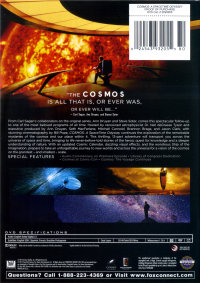
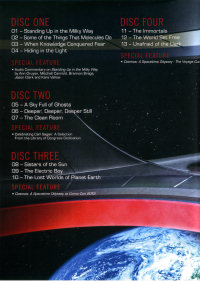
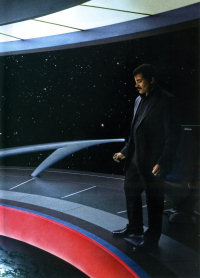
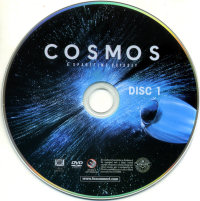



![]() Image
Image
Produced, of course, completely digitally, Cosmos - A Spacetime Odyssey did not have to be re-digitized or retransfered for these discs, the high-definition master just had to be converted into DVD format. This even today sometimes does not work out well, but it was done extremely well here.
The image looks practically flawless, like a raw and unmodified downsizing of the original HD master. There is no visible evidence of any sort of filter being used, but even without additional sharpening the image is enormeously detailed and certainly uses every last pixel of the available DVD resolution. A few scenes look intentionally soft, but the majority of the series looks very crisp and especially the animated sequences leave the impression of being painted directly on the screen. There is no video noise, film grain or other artefacts except when older stock footage is used. The aspect ratio fills the 16:9 screen completely except in a few instances where older footage, some of it from the original series, is used - then the image is windowboxed with black bars at the sides to preserve the original image without cropping. The credit sequence also has black bars, but on the top and bottom creating a "scope" 2.40:1 aspect ratio, bringing even more of a cinema feeling to the series.
The authoring is also completely unproblematic despite a worryingly low bitrate - but the MPEG encoder copes perfectly with the series by using very dynamic and always changing bitrates. On closer inspection, there may be a few isolated compression artifacts, but nothing major or permanently annoying is visible. Even with almost three hours of material on each disc, Cosmos - A Spacetime Odyssey looks as good as possible in NTSC resolution.
![]() Sound
Sound
Cosmos - A Spacetime Odyssey was already produced with a 5.1 soundtrack for the television broadcast, so there was no remix or upmix required for the home video releases. The Region 1 release only contains the original English soundtrack of the series.
The English 5.1 soundtrack has been encoded with the maximum 448 kbit/s and boasts a very modern mix rivaling even big-budget Hollywood productions. The surround sound is very immersive with Alan Silvestri's music filling up most of the speakers and an elaborate mesh of sound effects providing the rest and there are even a lot of discrete surround effects. The voice of Neil deGrasse Tyson has been integrated perfectly in the mix and has almost the same solid and warm quality throughout the whole series, although it was apparently recorded in many different locations - unlike the original Cosmos with the less than perfect voice recording. The voices of the actors in the animated sequences have a likewise perfect sound. The overall sound is very well balanced and while bass and trebles are distinctly pronounced, the fine dynamic never lets the soundtrack get too loud or annoying.
Four subtitle tracks in English, Spanish, French and Portugese are provided, the English track is an accurate transcription of the dialogue.
![]() Extras
Extras
When the release of Cosmos - A Spacetime Voyage was announced, not much was known about the extras at first, producing fears that Fox would release the show completely bare-bones. But the exact opposite happened: there were no extended episodes, but almost two hours of extras plus an audio commentary on the first episode. The menu design is minimal, but elegant and functional - strangely, there are no chapter menus for the separate episodes.
The Audio Commentary on the first episode has Ann Druyan, producer Mitchell Cannold, director Brannon Braga, special effects supervisor Jason Clark and animation producer Kara Vallow discussing the making of the show with great reverence and respect to Carl Sagan, but also with much earned enthusiasm and pride. Many aspects of the show's production are mentioned, although not in too much depth because of the relatively short running time of only 45 minutes - more commentaries would have been interesting, but this is still a very interesting conversation and a great tribute to Carl Sagan, who undoubtedly would have had participated in a commentary track himself.
All other extras are spread over the remaining three discs.
Disc 2
Celebrating Carl Sagan: A Selection from the Library of Congress Dedication (34:34) is an excerpt with the appearances of Seth McFarlane, Neil deGrasse Tyson and Ann Druyan from the dedication ceremony on November 12th, 2013. Sadly, this DVD omits some of the other speakers including Bill Nye for some reason, but the complete, 127-minute recording can be seen on Youtube here.
Disc 3
Cosmos - A Spacetime Odyssey at ComicCon 2013 (40:00) is the first public presentation of the series at the ComicCon, including the trailer, an intro by Seth McFarlane and the complete panel show with Ann Druyan, Brannon Braga and Neil deGrasse Tyson, moderated by british showmaster and science-fiction fan Jonathan Ross. This is also available on Youtube, but the version on the DVD and Blu-Ray is complete and an important and fun document of the history of the series.
Disc 4
Cosmos - A Spacetime Odyssey - The Voyage Continues (41:17) is a short, but concise documentary about the evolution and creation of the new Cosmos. It seems to have been produced for the television broadcast, but is solid enough to be much more than just an overgrown commercial. Among the people interviewed are Ann Druyan, Seth McFarlane, Neil deGrasse Tyson, producer Mitchell Cannold, director Brannon Braga, executivepProducer Jason Clark, Production Designer Seth Reed, cinematographer and director Bill Pope, visual effects producer Natasha Ann Francis and Rainer Gombos, science consultant Andre Bormanis, animation producer Kara Vallow, and composer Alan Silvestri, talking about almost every aspect of the show's production.
